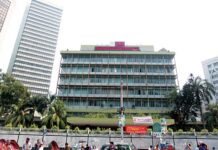Bangladesh has to address infrastructure deficits immediately for higher economic growth, M Teresa Kho, country director of Asian Development Bank, said yesterday.
“It must grow much faster, if poverty is to be completely eradicated in less than a decade’s time,” she said, while highlighting the need for more trade openness, higher exports and investment.
The country has the potential for much higher growth due to its “advantageous location” and availability of a “large labour force”.
Kho’s comments came at a luncheon meeting organised by the Foreign Investors’ Chamber of Commerce and Industry (FICCI) at The Westin Dhaka.
Although the country has come “a long way” in its quest for attaining faster economic growth and poverty reduction, major challenges still remain, she said.
“The rising labour cost in several Asian countries is opening up the prospect of foreign investors relocating to Bangladesh. But to make the best of it, Bangladesh needs to sharpen its focus on making up its infrastructure deficits,” she said.
Kho also stressed the need for greater intra-regional trade.
“Regional cooperation is a key thrust area for ADB as it plays a critical role in accelerating economic growth, reducing poverty and economic disparity, raising productivity and employment and strengthening institutions.”
While the country is a leading exporter of garments to the US and the European Union, its intraregional trade is still small, according to Kho.
Citing the country’s trade share of 11.4 percent with the South Asian region in fiscal 2011-12, she said: “Clearly, there is ample room for Bangladesh’s trade to grow.”
“Despite South Asia’s impressive growth since the early 2000s, it remains one of the least integrated regions in the world.”
South Asia accounts for only 2 percent of world trade and 1.7 percent of the world’s foreign direct investment. Intraregional trade is less than 6 percent of the region’s total trade, while it is 17 percent for Latin America, 8 percent for Middle East and North Africa and 55 percent for East Asia.
“In South Asia, some countries trade mostly within the region, while others trade mostly with the rest of the world. For example, landlocked Bhutan and Nepal trade mostly within South Asia, while Bangladesh and Sri Lanka, having direct access to seaports, trade mostly with the rest of the world,” Kho said.
However, exports within the region for Bangladesh at 3 percent, India at 5 percent and Sri Lanka at 6 percent are “very small”.
“Intraregional trade in South Asia is impeded not only by high costs of lengthy processes but also due to the absence of the trade and transport agreement between countries,” she said, adding that nearly all South Asian economies spend more than half of their trade costs on paperwork.
However, in recent years, the government has given special attention to improving cross-border trade with neighbouring countries,
she said.“But insufficient infrastructure connectivity and high transportation costs and limited access to trade finance impede trade.”
Kho also urged the country’s manufacturers to diversify its export basket. “Bangladesh is already a top player in the global garment business, but there is unrealised potential in other manufacturing activities, where a large number of jobs can be created.”
ADB has so far provided over $ 14.1 billion for 234 loans and around $222 million for technical assistance, she said.
Syed Ershad Ahmed, president of FICCI, urged the ADB country director to play a more proactive role in overcoming the huddle of the Padma Bridge project.
FICCI Vice-President Jim McCabe also spoke.
Source: The Daily Star










